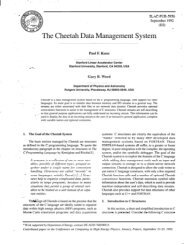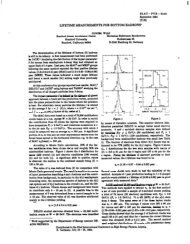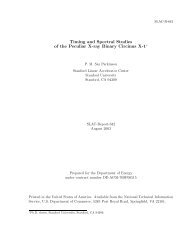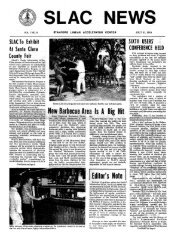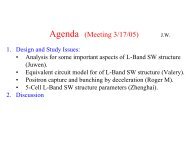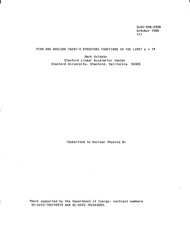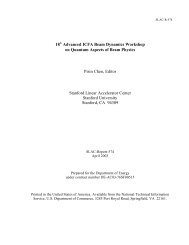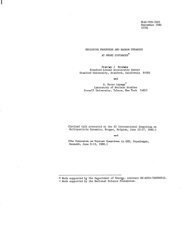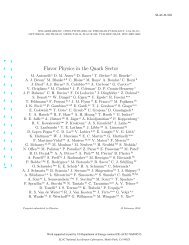SLAC-PUB-1706 - SLAC - Stanford University
SLAC-PUB-1706 - SLAC - Stanford University
SLAC-PUB-1706 - SLAC - Stanford University
Create successful ePaper yourself
Turn your PDF publications into a flip-book with our unique Google optimized e-Paper software.
-5 -<br />
We have taken further data in this region recently, and the results are<br />
shown on a more expanded scale in Fig. 8. What might have been a statistical<br />
fluctuation at 3.95 GeV before is now clearly seen to be some kind of a state, and<br />
the 4.4 GeV resonance is confirmed. There may be still more structure in this<br />
region, and considerably more data will be required to settle the question. We will<br />
try to have the answer in the next three to four months.<br />
The widths and areas of the states in this region are very difficult to obtain<br />
quantitatively. There are three reasons for the difficulty. First, all of this<br />
rapid cross section variation is taking place in a single angular momentum chan-<br />
nel, the PC = l-- state. The resonances may interfere with each other. Second,<br />
the transition between the low energy and high energy plateau regions indicates<br />
that new channels are opening in this region. It is well known that threshold<br />
effects can badly distort the shape of a classical Breit-Wigner line. Third, the<br />
shape of llbackgroundY1 in the transition region is not well known. The separation<br />
of the cross section into ‘lbackground” and “resonance” contributions is difficult,<br />
and line shapes can be further complicated by interference with the background.<br />
The masses, widths, areas, and couplings to the e+e- systems are sum-*-<br />
marized in Table II.<br />
Table II<br />
Summary of the masses, widths, areas, and couplings to<br />
the e+e- systems.<br />
Mass<br />
WV)<br />
3.1<br />
3.7<br />
3.95<br />
4.1<br />
4.4<br />
r tot<br />
WeV<br />
0.069<br />
0.225<br />
60.<br />
200<br />
40<br />
u dE* J<br />
re+e-<br />
(nb-GeV) WV)<br />
10.4 4.8<br />
3.7 2.2<br />
0.35 0.2<br />
2.5 1.8<br />
0.25 0.2<br />
The properties of $ and z+!J’ are well determined, but the widths and areas of the<br />
other three states are uncertain by 50%. In particular, I have assumed that the<br />
4.1 GeV region is a single state, which is by no means sure.<br />
In the next few months, we will go over this region with smaller energy steps<br />
and better statistics to determine if still more states exist. A study of Fig. 5 will<br />
convince you that there is no large energy span sufficiently well mapped to exclude<br />
either more 20-50 MeV wide states like the 4.4 or even more small, very narrow<br />
ones.



